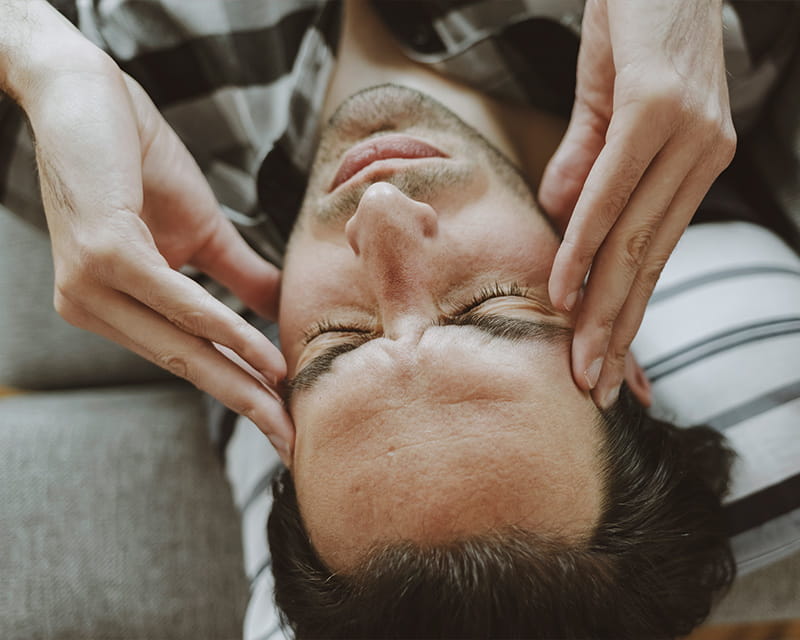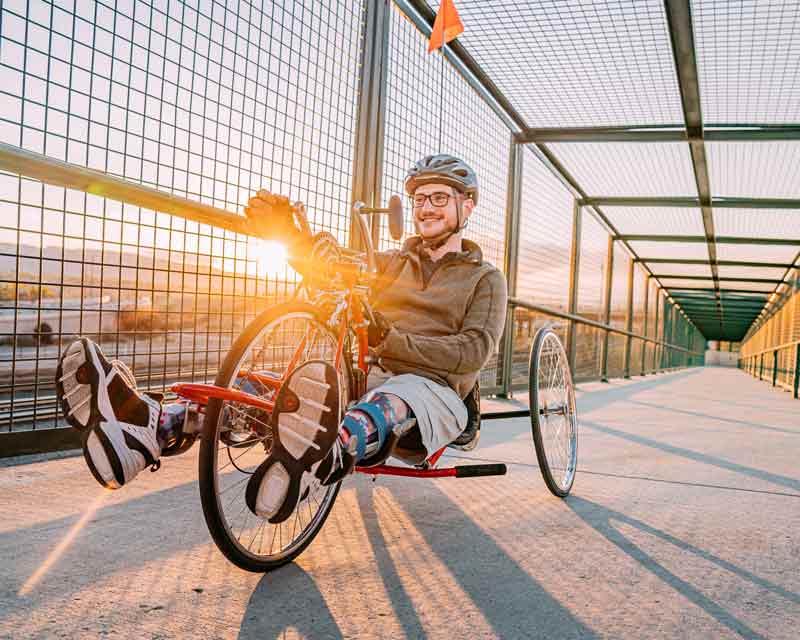
An innovative treatment for chronic post-traumatic headaches
 An interdisciplinary program at The Ohio State University Wexner Medical Center and the Ohio State College of Medicine Department of Physical Medicine and Rehabilitation that makes it easier for people with disabilities to take part in sports and recreational activities is helping improve patients’ overall health and allowing physically challenged people of all athletic abilities to live life more fully.
An interdisciplinary program at The Ohio State University Wexner Medical Center and the Ohio State College of Medicine Department of Physical Medicine and Rehabilitation that makes it easier for people with disabilities to take part in sports and recreational activities is helping improve patients’ overall health and allowing physically challenged people of all athletic abilities to live life more fully.
The idea for the program grew out of a desire to promote health and wellness in athletes with disabilities, explains Theresa Berner, OTR/L, ATP, rehabilitation clinical manager at the Ohio State Wexner Medical Center.
Berner, who is responsible for the medical center’s Assistive Technology Center, saw that when wheelchair athletes visited a physician for an injury, they’d receive treatment, but little help for the underlying problem that led to their injury. The treating physician or therapist knew the orthopedic aspects of care, but did not have an awareness of the potential influence that the equipment had on the problem at hand. It was the athlete’s seating clinician who knew the patient’s wheelchair and how potential wheelchair adjustments could reduce a medical complication. It was also evident that people did not know where to go to participate in adapted sports.
“We realized we needed to bring these worlds together,” Berner says.
What resulted was the Adapted Sports Institute, a program that has served hundreds of people high school age and older since its inception in 2015.
The institute is a natural fit at the Ohio State Wexner Medical Center, where physical medicine and rehabilitation physicians work to address the many impacts — physical, emotional, psychological, social and financial — disability may have on one’s life.
The center’s Dodd Rehabilitation Hospital and Outpatient Rehabilitation Programs are accredited by the Commission on Accreditation of Rehabilitation Facilities (CARF) and nationally recognized. The medical center is also a model system for traumatic brain injury.
According to Sam Colachis, MD, director of the Spinal Cord Injury Rehabilitation Program, the Adapted Sports Institute is one of the many tools the Ohio State Wexner Medical Center offers to his patients to help them rebuild their lives and achieve a higher level of independence.
“A spinal cord injury is one of the most catastrophic injuries one can endure,” he says. “It essentially separates your mind from your body. You have your goals and aspirations, but you’ve lost the ability to attain them and at the same time, you’re at risk of many serious complications.”
Through a lifelong continuum of care that starts at the time of injury, physicians and other specialists at the Ohio State Wexner Medical Center work together to help patients once again focus on their aspirations and turn their hopes and goals into reality, he says. Referrals to the program, if and when patients are interested, allows them to focus on their abilities, promotes rehabilitation and overall wellness, and reduces the risk of injury-related complications.
While people with spinal cord injuries make up a significant portion of those assisted through the Adapted Sports Institute, people with disabilities related to all types of conditions, from traumatic brain injuries to amputations and other orthopedic and neurologic conditions, are eligible to participate.
“If someone can’t participate in a sport in the regular way, we can find a way to adapt it,” Berner says.
The Adapted Sports Institute brings together clinicians and providers from across the medical center and academic community. This group of experts makes up the adaptive sports and wellness team. Jonathan Napolitano, MD, who is an assistant professor in the Department of Physical Medicine and Rehabilitation at The Ohio State University, and director of the Adaptive Sports Medicine Program at Nationwide Children's Hospital in Columbus, serves as the medical director of the adaptive sports and wellness team.
Other team members include:
Working together, the team offers services including patient screenings, equipment assessments and measurements, and help with adaptive equipment selection. Because adaptive sports equipment is expensive and typically not covered by insurance, the team also maintains an extensive list of funding sources and offers grant-writing assistance.
“We help people navigate the system and make sure that if they’re going to invest several thousand dollars in a hand cycle, for example, that they’ve tried it out, they know what they’re getting into and they get the right fit,” Berner says. “Then, we’ll actually help them procure it.”
The team also offers guidance for sports performance and injury prevention and working under physician supervision, provides up-to-date, evidence-based treatments if injuries do occur. Additionally, they provide a yearly symposium for providers who work with wheelchair athletes.
The adaptive sports and wellness team includes specialists from Nationwide Children’s Hospital in addition to the Ohio State Wexner Medical Center. Team members meet monthly to discuss cases and collaborate on outreach efforts and research opportunities.
The hospitals don’t directly offer sports programs, but the team maintains an adaptive sports community calendar, which highlights the many sports and recreational programs available through community partners in the Columbus area. A key goal of the team is to simply get the word out that these opportunities exist and are safe and beneficial. Research shows some people don’t know about them until years after their injury.
With options that include everything from wheelchair rugby and basketball to skiing, swimming, hockey and soccer for the visually impaired, there’s something for everyone. Participants consist of competitive athletes, including some who have taken part in the Paralympics, as well as those simply looking for an opportunity to be active or try something new. Activities like biking, yoga and dance are also available for people who are interested in alternative athletics.
“We have the unique ability to bring together the community, the academic world and the medical world,” Berner says. “We use all of our strengths to really support each other so the athlete will benefit.”
And how do participants benefit?
For starters, they can improve cardiovascular fitness and reduce the risk of problems such as obesity, stroke and heart attack, according to Colachis. Being active also reduces the risk of pressure sores, musculoskeletal complications and blood pressure issues in spinal cord injury patients.
But the benefits aren’t just physical. Participants often report decreased depression and anxiety, improved self-identity and better ability to cope.
“I’ll often tell someone who’s newly injured, if you’re not ready to participate, just go and watch,” Berner says. “What happens is they find a community of support.”
They often also find a new outlook on life.
“The thing that makes me most proud is watching the athletes compete — the smiles, the drive, the accomplishments,” Napolitano says. “When someone is adjusting to a new injury or disability and things are taken away from them and certain limitations are identified, those are always sad moments or challenging moments. But when they’re transitioning into adaptive sports it’s really impressive to see how athletes will often surprise themselves. They no longer see what their disabilities are, but what their abilities are.”
Madison Hyzdu is one program participant who has experienced that feeling of surprise. Now 24, she became a quadriplegic in August 2020, after a fall caused by postural orthostatic tachycardia syndrome related to Ehlers-Danlos. A C1, C2 incomplete spinal cord injury that left her with limited use of her hands resulted.
Then an Arizona resident, Hyzdu returned to Ohio specifically for the rehabilitation services offered through Ohio State and the adaptive sports opportunities available in the area, both of which she had hoped would bolster her stalled recovery.
Hyzdu was a frequent kayaker when she was younger, so kayaking was the first adapted sport she tried in the summer of 2021. She admits she was scared getting into the water that first time, but with the special equipment that made it possible and the support of volunteers who surrounded her, she quickly felt safe and confident.
Cycling, which involved powering her bike with her hands, followed kayaking. That brought about new fears, but it was also when things really began to change for her.
“I was afraid it was going to be a source of discouragement and that I wouldn’t be strong enough to propel the bike,” she says. “I didn’t want it to be another thing on my list of things that I wasn’t able to do. But once I actually started cycling, it was amazing. I was able to do it and I didn’t need any help. It was really freeing.”
Besides giving her a mental boost, after several months, the activities improved strength in her hands and core, allowing her to do her own transfers for the first time since her accident and making it easier to do activities like brushing her teeth and combing her hair.
“As I gained strength, I was able to realize that there was light at the end of the tunnel,” she says. “I hate that phrase, but it’s true. My circumstances of relying on other people all the time weren’t going to be a reality forever. I could see myself living in an apartment and functioning well on my own.”
Skiing is the next activity Hyzdu plans to try, and she’s quick to give credit to the adapted sports team for helping make it possible.
“I think the beautiful thing about adaptive sports is that you’re able to celebrate the fact that you have a disability but can also enjoy life and overcome the challenges it presents,” she says. “Having a team like Ohio State’s — they help make working through those challenges so much easier.”